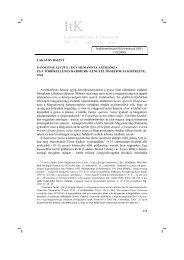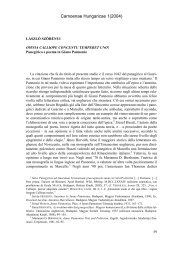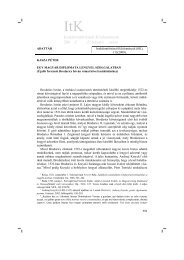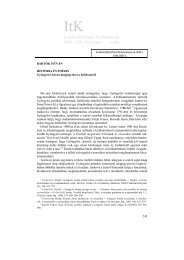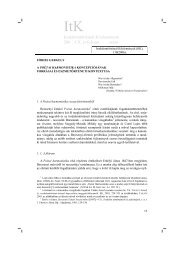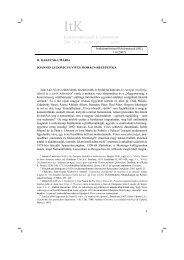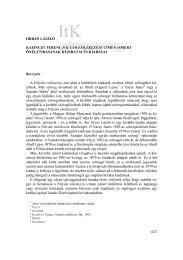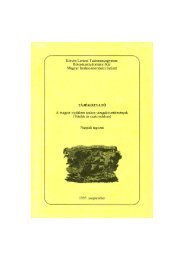Camoenae Hungaricae 3(2006) - Irodalomtörténeti Közlemények
Camoenae Hungaricae 3(2006) - Irodalomtörténeti Közlemények
Camoenae Hungaricae 3(2006) - Irodalomtörténeti Közlemények
Create successful ePaper yourself
Turn your PDF publications into a flip-book with our unique Google optimized e-Paper software.
<strong>Camoenae</strong> <strong>Hungaricae</strong> 3(<strong>2006</strong>)<br />
It is difficult to ignore the parallels and analogies that make themselves conspicuous at<br />
this point. Marsili’s “Hungarians” bear a striking resemblance to the Patria he left behind,<br />
to the freedom-loving, rebellion-prone citizens of Bologna. The town which for<br />
centuries maintained a delicate power equilibrium between the papal Legate, the local<br />
aristocracy and the Bentivoglio family which rose out of the latter and managed the incessant<br />
conflicts with continuous compromises, was not called a “contractual republic”<br />
(repubblica per contratto) 100 for no reason. The power structure Marsili found in Hungary,<br />
this hardly comprehensible, intricate network of privileges and autonomies, could<br />
hardly be foreign to him. The novel aspect of the Prodromus is the empathy, the tone of<br />
understanding towards the Hungarians missing from his earlier works (like from Relazione<br />
dello stato dell’Impero Romano-Germanico 101 which was in favour of discarding all<br />
forms of autonomy), the rejection of the Utopian rigor and its transformation into a civilizing<br />
discourse, the projection of the Roman past, with its network of roads and structure<br />
of borders, onto the entirety of the Central European region. This “project” of course, is<br />
not free of political motivations in the plans for the Acta, however, unlike in the case of<br />
the Danubius, these motivations are not dependent on the immediate interests of one<br />
given state, but are part of a grander perspective encompassing all of Europe. It is no<br />
accident that Marsili starts to “forgive” the Hungarians whom he earlier characterized as<br />
incorrigible rebels and enemies of progress, when his wrath prompted by the “wickedness”<br />
of his Patria also subsides. It must have been no mean feat to distance himself from<br />
the teachings of his former masters such as Raimundo Montecuccoli or Antonio Caraffa<br />
and discover a potential Europe reborn from the antiquity in Bologna or on the banks of<br />
the Danube. This Europe was in the training received by the youth of the nobility in the<br />
Bologna Institute, in the uniforms worn by the Papal troops defending Bologna (designed<br />
after the ancient Roman models), 102 in the antique inscriptions unearthed in the Danube<br />
valley. I am not saying Marsili had gone all the way down this road, but the Prodromus<br />
sibi vero etiam ad ampliores victorias tandem aliquando impedimento essent. Verumenimvero sicuti nationis<br />
omnis natura atque ingenium et ex eiusdem sanguine constat, et caelo regionum effingitur, et instituitur educatione<br />
quam a parentibus quisque nostrum hausit et expressit, ita plane difficile atque asperum factu est ipsam<br />
naturam mutare aut refingere. Eadem causa quamvis nequidquam illi genti minus, quam moltitudo casuum<br />
defuit, nunquam tamen est factum ut ad saniora consilia ineunda impellerentur. Verum cum historiarum<br />
monumenta variis tantae nationis casibus plena sint: adeant illa curiosiores legentium animos, si diligentius<br />
generosae huius gentis egregia facinora perquirant.” Prodromus, without pagination.<br />
100 See Angela DE BENEDICTIS: «…sendo le parte de’ Bentivogli et confirmata et unita»: Per una storia<br />
del costituirsi dei rapporti di potere in una realtà della prima età moderna, in: «Familia» del principe e<br />
famiglia aristocratica, a cura di Cesare MOZZARELLI, Bologna, 1988, 437–469; ID., Repubblica per contratto<br />
(Bologna: una città europea nello Stato della Chiesa), Bologna, 1995.<br />
101 BUB Ms 96, fasc. A. In this he talked about the Hungarians, who were to be enslaved, expressing views<br />
even more severe than those of Raimondo Montecuccoli (GHERARDI 1980, op. cit., 77–80). In his border<br />
survey reports he combines a hard-line, military approach with the more practicable, economy-oriented model<br />
of the Einrichtungswerk (GHERARDI 1980, op. cit., 262–271).<br />
102 STOYE 1994, op. cit., 273. noticed and highlighted the significance of the fact that Marsili intended to<br />
equip, lead and dress the army to be set up for the defense of the Papal State on the model of the antique<br />
Roman Legions.<br />
139



